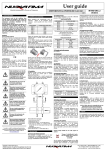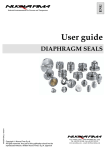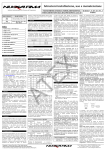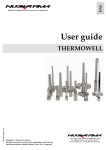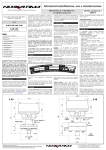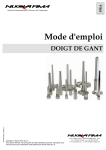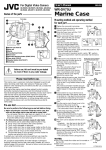Transcript
User guide Industrial instrumentation for Pressure and Temperature 1. General information The instrument described in this manual has been designed and produced in conformity to the following standards: EN 837-1-2 ed alla ASME B40.1. All components are submitted to severe quality and traceability controls. The quality management system is certified according to the ISO 9001 standard. This manual contains important information about the use and the installation of the gauge in safe conditions. Therefore it is highly recommended to read carefully the following instructions before using the instrument. The instrument works in safe conditions when correctly selected and installed in the system and when the rules concerning the product as well as the maintenance procedures established by the manufacturer are respected. The staff charged with the selection, installation and maintenance of the instrument must be able to recognize the conditions that may negatively affect the instrument's ability to work and which may lead to premature breakage. The staff must therefore be technically qualified and properly trained, and must carry out the procedures called for in the plant regulations. Standards - Directive P.E.D. 97/23/CE Nuova Fima instruments are designed and manufactured according to the safety rules included in the safety international standards in force. According to the 97/23/CE standard the NUOVA FIMA pressure gauges are classified in 2 categories PS ≤1000 bar these instruments should not satisfy the essential safety standards but they have only to be designed and manufactured according to a SEP-Sound Engineering Practice and they do not have to bring any CE marking. PS >1000 bar these instruments should satisfy the essential safety standards established by the PED, they are classified as category I and they are certified according to Form A. They should bring the CE marking as reproduced below. 1.1 Intended use These instrument are designed for Sanitary, Food Process and Pharmaceutical Industries in compliance with standard n° 74-03 of 3-A. The absence of interstices and the mirror finishing of the components assure the best hygiene. To reduce the effects of severe operating conditions like vibrations and pulsation, the instrument can be liquid filled 2. Installazione Before installation be sure that the right instrument has been selected following the working conditions and in particular the range, the working temperature and the compatibility between the material used and the process fluid. This manual does not concern the instruments conforming to standard 94/9/CE (ATEX). The product warranty is no longer valid in case of non-authorized modifications and of wrong use of the product. The manufacturer disclaims all responsibility in case of damages caused by the improper use of the product and by the non-respect of the instructions reported in this manual. SANITARY and OMOGENIZER PRESSURE GAUGES SP-OM Disconnect the instruments only after depressurization of the system. The process fluids residuals in the disassembled gauges could affect people, the environment and the system. It is highly recommended to take proper precautions. In order to verify the working and manufacturing features of the instruments read the catalogue sheets in the most up-dated edition available on-line on www.nuovafima.com The instrument installation should be carried out according to standard EN 837-2 (Recommendation for pressure gauges installation and selection) - Remove the diaphragm protection just before mounting treating it with extreme care. Scratches on the diaphragm are the main risk of chemical corrosion while crashing pressure on the concentric waviness affect the correct system operation. - A chemical compatibility check between the process medium and the wetted parts is requested before installation. A description about the instrument material is marked by laser on the upper and lower body of the instrument as well as on the seal label. - It is recommended to select approved seals for food treatment. The quick connection components such as clamps, pulleys, flanges and nuts are not included in the supply and they are not described in this manual. - Instruments with the DIN 11851 connection must be installed using special gaskets type SKS. - Instruments with process connection conformed to ISO 2853 (IDS/ISS) must be installed using those gaskets with supporting ring as described in the above mentioned directive. - In case of fluids leakage during mounting, clean carefully. - As for gauges with security device installation should guarantee a free space on the back side of 20mm at least. - In order to guarantee the accuracy in measuring it is necessary to respect the working limits described in the catalogue sheets. - Instruments should be installed in vibrations proof positions. If the mounting point is not stable because of vibraions a support for the instrument fixing should be used such as a clamp or a flange , possibly use a flexible capillary. - If vibrations cannot be prevented during installation, use liquid filled instruments. - The instrument mounting according to standard EN 837-1 /9.6.7 established the vertical position as standard mounting. Calibration and therefore mounting positions different from standard (when requested) are shown on the dial. - Instruments must be protected from wide ambient temperature variations. - Instruments must be protected from sun radiations during working in order to prevent overheating. - Liquid filled instruments used in temperatures lower than 20°C, could have higher response times because of the increase of viscosity of the filling liquid. - During installation be sure that no deviation above or below the fluid allowed and the ambient temperatures takes place considering the heating radiations. It is necessary to consider the temperature influence on the accuracy value. - During the first operating procedure all pressure rush should be prevented. Slowly open the interception valves. - The use of instruments measuring the zero values is not recommended especially in gauges where the first part of the scale is suppressed. - It is not recommended to reinstall the instruments on plants working with different process fluids in order to prevent any chemical reaction which could cause explosions owing to contamination of the wetted parts. - If the pressure indication stays fixed for a long time be sure that this is not due to a closing up of the pipe bringing the pressure to the sensing element. Before disassembling especially in case of pressure with zero value be sure that there is no pressure inside the gauge isolating it through the interception valve. The user is totally responsible for the instrument installation and maintenance. Copyright Nuova Fima S.p.A. Tutti i diritti riservati. Nessuna parte di questa pubblicazione può essere riprodotta in alcuna forma senza permesso scritto rilasciato da Nuova Fima S.p.A. 3. Use limits 3.1 Process and ambient temperature This standard type instrument is designed to be used in safety conditions that is in an ambient temperature between –40 and +65°C. As for the filled model please see the paragraph “DAMPENING LIQUID FILLING” In case of temperatures below 0°C, it is recommended to use liquid filled gauges preventing that the components such as the measuring system toothing can freeze. The fluid must not freeze or crystallize inside the sensing element. 3.2 Working pressure The instrument should be chosen considering the scale range which should be between 25% and 75% of the full scale range. The full scale range should be approximately double than the working pressure value. 3.3 Dynamic and cyclic pressures The dynamic and cyclic pressures are normally indicated by the measuring index oscillations. They reduce the sensing element’s and the amplifying mouvement’s life. It is necessary to reduce the pulsating pressures placing a dampner or a reducing valve between the pressure source and the instrument. The harmful effect of the pulsations could also be reduced filling the case with a dampening liquid.. An improper choice of the instrument can bring to a breakage by stress. 3.4 Overpressure Not applicable 3.5 Vibration Vibrations can be detected through continuous and often irregular oscillations of the index or of the case.. When the instrument is under vibrations it is recommended to use liquid filled pressure gauges. 3.6 Safety device In systems working with compressed gas it is recommended to choose an instrument with a proper safety device in accordance to standard EN 837-2. In case of unexpected breaking of the sensing element the compressed gas expands outside the case through the safety device. 3.7 Dampening liquid filling The dampening liquid is generally used to reduce vibrations of the moving parts due to vibrations and/or pulsations. It reduces considerably the use of the rotating parts increasing the instrument resistance to stress, increasing the instrument readability and it reduces the sudden loss of pressure. The dampening liquid type should also be choosen considering the working temperature, the liquid viscosity degree and the expected damping level. As for working temperatures of the liquid filled instruments please see the instrument’s catalogue sheet. 3.8 Protection in explosive ambient In case pressure gauges are used in potentially explosive atmospheres special procedures are requested. The directive regarding the ATEX products 94/9/CE is applied to pressure gauges with electrical devices as well as to mechaninical pressure gauges. In order to chose the products requiring these features please see the catalogue sheet and the manual. 4. Wrong use 4.1 Fatigue rupture A continuous pressure variation highlighted by oscillations of indication can reduce the elastic element’s life. These breakage, which could be more dangerous if occur in measuring compressed gas instead of liquids, cause a pressure increase inside the case and therefore the safety device opening. In case of operation with high pressure the breakage could degenerate in an explosion. It is recommended to use dampening liquid filled instruments and to narrow the pressure entrance conduit through a restrictor screw or am adjustable dampener. 4.3 Corrosion rupture The compatibility with the process medium is fundamental in preventing breakage for corrosion. The sensing element is generally less thick so it works in conditions of stress corrosion. None of the most common materials is immune from a chemical attack whose entity is influenced by concentration, MI-SP-OM-ENG_1 05/2012 temperature and the type of a mix of different chemical substances. In this case we recommend to use a diaphragm seal produced in the proper material. The customer is entirely responsible for the choice of the instrument material which should be the most proper one for the process medium. 4.5 Vibration and shocks rupture Vibrations most commonly cause an abnormal deterioration of the parts in mouvement bringing to a gradual loss of accuracy and then to a total block of the pointer. Vibrations could also cause stress cracks in the sensing element structure causing a liquid leakage and even an explosion. 5. Maintenance The instrument’s characteristics should be maintained during time through a special maintenance program which should be carried out and managed by qualified technicians. All diaphragm seals are assembled and fixed to the instrument through a seal label. If this label or the assembling are altered improperly the whole system working and the relevant guarantee are affected. ATTENTION: Do not remove or slack the filling valve and do not separate the instrument from the diaphragm seal. In case of leakage the assembling is not working anymore and must be returned in order to proceed to a separating circuit refilling. The maintenance program includes: the cleaning of the external parts of the instrument by a humid cloth, the pressure indication check, the gaskets tightness check, condensate presence inside the case, the glass, case and safety device soundness. As for heavy work instruments operating in severe conditions plants (vibrations, pulsating pressures, corrosive or sedimentous fluids, fuel or inflammable fluids) we recommend to schedule their replacement according to the maintenance program schedule. In case the instrument does not work properly it is necessary to proceed to an unschedule checking procedure. Instruments should be kept in their original packaging and placed indoor and protected from humidity. The stocking area temperature should be between –25…and +65°C except different instructions. A careless moving of the instrument could affect the metrological features although it is properly packed. Instruments should be checked before use. In particular in the zero free instruments it could occur that the nullpressure pointer position is inside the zero span. 5.1 Verifica ordinaria Per verificare l’integrità dell’elemento sensibile, installare lo strumento sul generatore di pressione, interponendo tra i due, una valvola di intercettazione. Sottoporre lo strumento al valore massimo di pressione ed escluderlo dalla sorgente di pressione tramite la valvola. Eventuali perdite dell’elemento sensibile si noteranno dal lento ritorno a zero della lancetta. 5.2 Ricalibrazione Qualora i risultati della verifica della classe di precisione, mostrino valori rilevati diversi da quelli nominali dichiarati a catalogo, lo strumento dovrà essere sottoposto a ricalibrazione. Si raccomanda di restituire lo strumento a NUOVA FIMA per questa operazione. L’uso di uno strumento oggetto di interventi non autorizzati da NUOVA FIMA, lo esclude da ogni responsabilità e causerà l’invalidazione della garanzia sul prodotto. 6.Smaltimento Lo smaltimento inappropriato può provocare rischi per l’ambiente. Lo smaltimento dei componenti dello strumento e dei materiali di imballaggio deve essere effettuato in modo ecocompatibile ed in accordo alle normativa nazionali. Il fluido rimanente all’interno dello strumento può essere pericoloso o tossico all’ambiente, alle persone ed alle attrezzature. Via C. Battisti, 59/61 – 28045 INVORIO (No) – Italy Tel. +39 0322 253200 – Fax +39 0322 253232 www.nuovafima.com – e-mail: [email protected]

